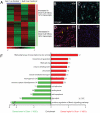Reversible block of mouse neural stem cell differentiation in the absence of dicer and microRNAs
- PMID: 20976144
- PMCID: PMC2956652
- DOI: 10.1371/journal.pone.0013453
Reversible block of mouse neural stem cell differentiation in the absence of dicer and microRNAs
Abstract
Background: To investigate the functions of Dicer and microRNAs in neural stem (NS) cell self-renewal and neurogenesis, we established neural stem cell lines from the embryonic mouse Dicer-null cerebral cortex, producing neural stem cell lines that lacked all microRNAs.
Principal findings: Dicer-null NS cells underwent normal self-renewal and could be maintained in vitro indefinitely, but had subtly altered cell cycle kinetics and abnormal heterochromatin organisation. In the absence of all microRNAs, Dicer-null NS cells were incapable of generating either glial or neuronal progeny and exhibited a marked dependency on exogenous EGF for survival. Dicer-null NS cells assumed complex differences in mRNA and protein expression under self-renewing conditions, upregulating transcripts indicative of self-renewing NS cells and expressing genes characteristic of differentiating neurons and glia. Underlining the growth-factor dependency of Dicer-null NS cells, many regulators of apoptosis were enriched in expression in these cells. Dicer-null NS cells initiate some of the same gene expression changes as wild-type cells under astrocyte differentiating conditions, but also show aberrant expression of large sets of genes and ultimately fail to complete the differentiation programme. Acute replacement of Dicer restored their ability to differentiate to both neurons and glia.
Conclusions: The block in differentiation due to loss of Dicer and microRNAs is reversible and the significantly altered phenotype of Dicer-null NS cells does not constitute a permanent transformation. We conclude that Dicer and microRNAs function in this system to maintain the neural stem cell phenotype and to facilitate the completion of differentiation.
Conflict of interest statement
Figures






Similar articles
-
Dicer is required for neural stem cell multipotency and lineage progression during cerebral cortex development.Neural Dev. 2013 Jul 29;8:14. doi: 10.1186/1749-8104-8-14. Neural Dev. 2013. PMID: 23895693 Free PMC article.
-
miRNAs are essential for survival and differentiation of newborn neurons but not for expansion of neural progenitors during early neurogenesis in the mouse embryonic neocortex.Development. 2008 Dec;135(23):3911-21. doi: 10.1242/dev.025080. Development. 2008. PMID: 18997113 Free PMC article.
-
RNAase-III enzyme Dicer maintains signaling pathways for differentiation and survival in mouse cortical neural stem cells.J Cell Sci. 2010 Feb 15;123(Pt 4):586-94. doi: 10.1242/jcs.059659. Epub 2010 Jan 26. J Cell Sci. 2010. PMID: 20103535 Free PMC article.
-
Decoding the ubiquitous role of microRNAs in neurogenesis.Mol Neurobiol. 2017 Apr;54(3):2003-2011. doi: 10.1007/s12035-016-9797-2. Epub 2016 Feb 24. Mol Neurobiol. 2017. PMID: 26910816 Review.
-
Pluripotent stem cell-derived somatic stem cells as tool to study the role of microRNAs in early human neural development.Curr Mol Med. 2013 Jun;13(5):707-22. doi: 10.2174/1566524011313050003. Curr Mol Med. 2013. PMID: 23642053 Review.
Cited by
-
Canonical microRNAs Enable Differentiation, Protect Against DNA Damage, and Promote Cholesterol Biosynthesis in Neural Stem Cells.Stem Cells Dev. 2017 Feb 1;26(3):177-188. doi: 10.1089/scd.2016.0259. Epub 2016 Dec 9. Stem Cells Dev. 2017. PMID: 27762676 Free PMC article.
-
MiR-485-3p modulates neural stem cell differentiation and proliferation via regulating TRIP6 expression.J Cell Mol Med. 2020 Jan;24(1):398-404. doi: 10.1111/jcmm.14743. Epub 2019 Nov 15. J Cell Mol Med. 2020. PMID: 31730275 Free PMC article.
-
Long nonding RNA UCA1 regulates neural stem cell differentiation by controlling miR-1/Hes1 expression.Am J Transl Res. 2017 Aug 15;9(8):3696-3704. eCollection 2017. Am J Transl Res. 2017. PMID: 28861160 Free PMC article.
-
Role of miRNAs in Brain Development.Microrna. 2024;13(2):96-109. doi: 10.2174/0122115366287127240322054519. Microrna. 2024. PMID: 38571343 Review.
-
Synergic Functions of miRNAs Determine Neuronal Fate of Adult Neural Stem Cells.Stem Cell Reports. 2017 Apr 11;8(4):1046-1061. doi: 10.1016/j.stemcr.2017.02.012. Epub 2017 Mar 16. Stem Cell Reports. 2017. PMID: 28330621 Free PMC article.
References
-
- Bartel DP, Chen CZ. Micromanagers of gene expression: the potentially widespread influence of metazoan microRNAs. Nat Rev Genet. 2004;5:396–400. - PubMed
-
- Ambros V. The functions of animal microRNAs. Nature. 2004;431:350–355. - PubMed
-
- Kosik KS, Krichevsky AM. The Elegance of the MicroRNAs: A Neuronal Perspective. Neuron. 2005;47:779–782. - PubMed
-
- Cheng LC, Tavazoie M, Doetsch F. Stem cells: from epigenetics to microRNAs. Neuron. 2005;46:363–367. - PubMed
-
- Lagos-Quintana M, Rauhut R, Yalcin A, Meyer J, Lendeckel W, et al. Identification of tissue-specific microRNAs from mouse. Curr Biol. 2002;12:735–739. - PubMed
Publication types
MeSH terms
Substances
Grants and funding
LinkOut - more resources
Full Text Sources
Other Literature Sources
Medical
Molecular Biology Databases
Miscellaneous

